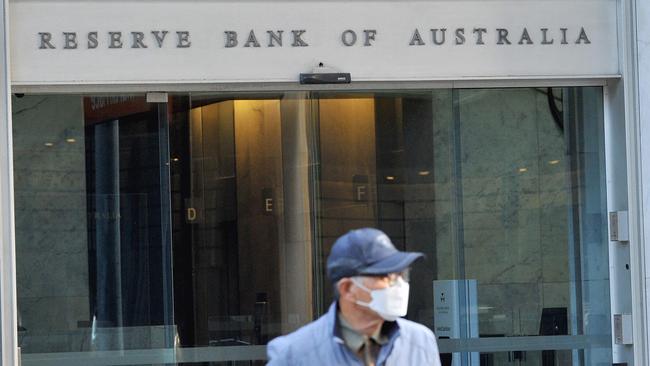Recession fears ease with households in good shape
Reserve Bank research shows that even if rates rise as far as some predict, principal and interest mortgage payments would be similar to what households were making early this year.

Fears of a deep recession in Australia if interest rates rise as much as expected may be overstated.
Reserve Bank research shows aggregate principal and interest mortgage payments would be similar to the total payments households were making – including excess payments – early this year.
Researchers said the household sector entered the interest rate tightening cycle that began in May “in a strong financial position” and was “reasonably well placed to adjust” to higher interest rates.
Household assets were six times household debt, compared to 5½ times at the end of 2019, household wealth rose strongly in the past two years, and low rates and jobs growth saw households add to large savings in the first half of 2022, the RBA said in its six-monthly Financial Stability Review.
The risk of financial instability linked to household debt was “mitigated by a large increase in liquidity buffers” since the start of the pandemic, the review found.
Balances in offset and redraw accounts rose by $110bn – or 7 per cent of household disposable income – since March 2020, and indebted households “continued to add to their already large liquidity buffers in recent months despite the rise in minimum loan payments”. “Consistent with this, housing loan arrears rates remain very low,” the RBA said.
Rate increases and high inflation had reduced the amount of spare income available to households after basic living expenses, which had “placed some strain on household budgets”.

Total scheduled payments on housing loans are expected to be 9 per cent of household disposable income by the end of 2023, based on the 2.5 per cent rise in the cash rate from May to October boosting variable loan payments and as fixed-rate loans roll off.
But if rates rise broadly in line with market expectations to the end of 2023, scheduled interest and principal payments are projected to be on par with the total payments – including excess payments – that households were making before rates started rising.
“This doesn’t mean other spending won’t be materially impacted by higher interest rates, but it does suggest that fears a cash rate above 3 per cent means a hard landing for the economy are overstated,” ANZ head of Australian economics David Plank said.
The RBA said most owner-occupiers with variable-rate mortgages “have the ability to adjust to a period of higher interest rates and inflation, in part due to their substantial savings buffers”. Only a “small share” of these borrowers were vulnerable to debt-servicing difficulties and default. Fixed-rate borrowers “have experienced rising cost-of-living expenses” and would face “potentially large increases in mortgage payments as their fixed-rate terms expire in the period ahead.”
For housing investors, strong rental demand should support income and loan payment capability as debt-servicing costs increase, even though higher rents and living costs have hit the cashflow of the third of Australians who rent.
The RBA noted “limited signs in the official data of a pick-up in financial stress” among Australian households to date, reflecting strong growth in employment and incomes.
“This is consistent with timely indicators that show household spending has held up in recent months and information from liaison with banks,” it said.

But other economists warn that a stable financial system doesn’t guarantee a strong economy. “While the RBA may be broadly content that most households can cope with higher interest rates and that banks are highly liquid, this does not mean that tightening financial conditions will not materially lower household consumption growth and consequently slow the economy in the coming period,” said CBA economist Harry Ottley.
Household perceptions of their financial situation had “weakened considerably” to levels seen early in the Covid-19 pandemic, as Google searches on “financial stress” and negative sentiment in the press trended higher, the RBA said. “Information from the bank’s liaison program also suggests that demand for a range of social and community services – including low-cost housing and food services – has increased of late,” the RBA said. “Increases in indicators of financial stress are likely in the period ahead.”
It said most indebted households were “well-placed to manage the recent increase in their housing and other living expenses” as they have had “sizeable spare income available after meeting their debt and basic living expenses and many have accumulated large savings buffers over recent years”.
New borrowers face a 3 per cent minimum interest rate buffer and most don’t borrow their maximum, so most start with a larger effective cashflow buffer than required by their lender. Many indebted households had “accumulated a sizeable stock of liquid savings that could be used to support their consumption and/or meet increased loan payments if necessary”, the RBA said.
As of August, more than 35 per cent of all borrowers had prepayment buffers – offset and redraw account balances – equivalent to more than two years of their minimum payments, and almost a quarter had buffers of between three months and two years.

For the median owner-occupier variable-rate borrower, mortgage prepayment balances in offset and redraw accounts were enough to cover 20 months of required payments as at August, down from 22 months in April, reflecting the rise in interest rates and larger required payments.
Less than 40 per cent of borrowers had small mortgage buffers – covering less than three months of payments. Some 40 per cent of those with small mortgage buffers had fixed-rate loans, but fixed-rate borrowers and investors face contractual restrictions or disincentives against excess payments. “Accordingly, this subset of borrowers is likely to have liquid savings outside their mortgage accounts, and so this metric could overstate their vulnerability,” the RBA said.
Surveys have found investors have smaller buffers but more liquid assets than owner-occupiers.
The remainder of households with low prepayment buffers – about 20 per cent of all borrowers – were “more vulnerable to large shocks to their income or expenses, particularly if they entered the tightening cycle with little in the way of spare monthly cash flow.”
But in addition to large liquidity buffers, strong housing price growth in recent years gave most households “substantial equity buffers” in their homes.
Just 5 per cent of loans are estimated to have an outstanding loan-to-valuation ratio above 75 per cent as at August, very few loans were in negative equity, and “very large further declines in housing prices would be required to materially increase the share of loans in negative equity,” the RBA said. But recent home buyers were “more vulnerable to debt-servicing challenges and default” as rates rose, as they have had “less time to accumulate liquidity and equity buffers”.



